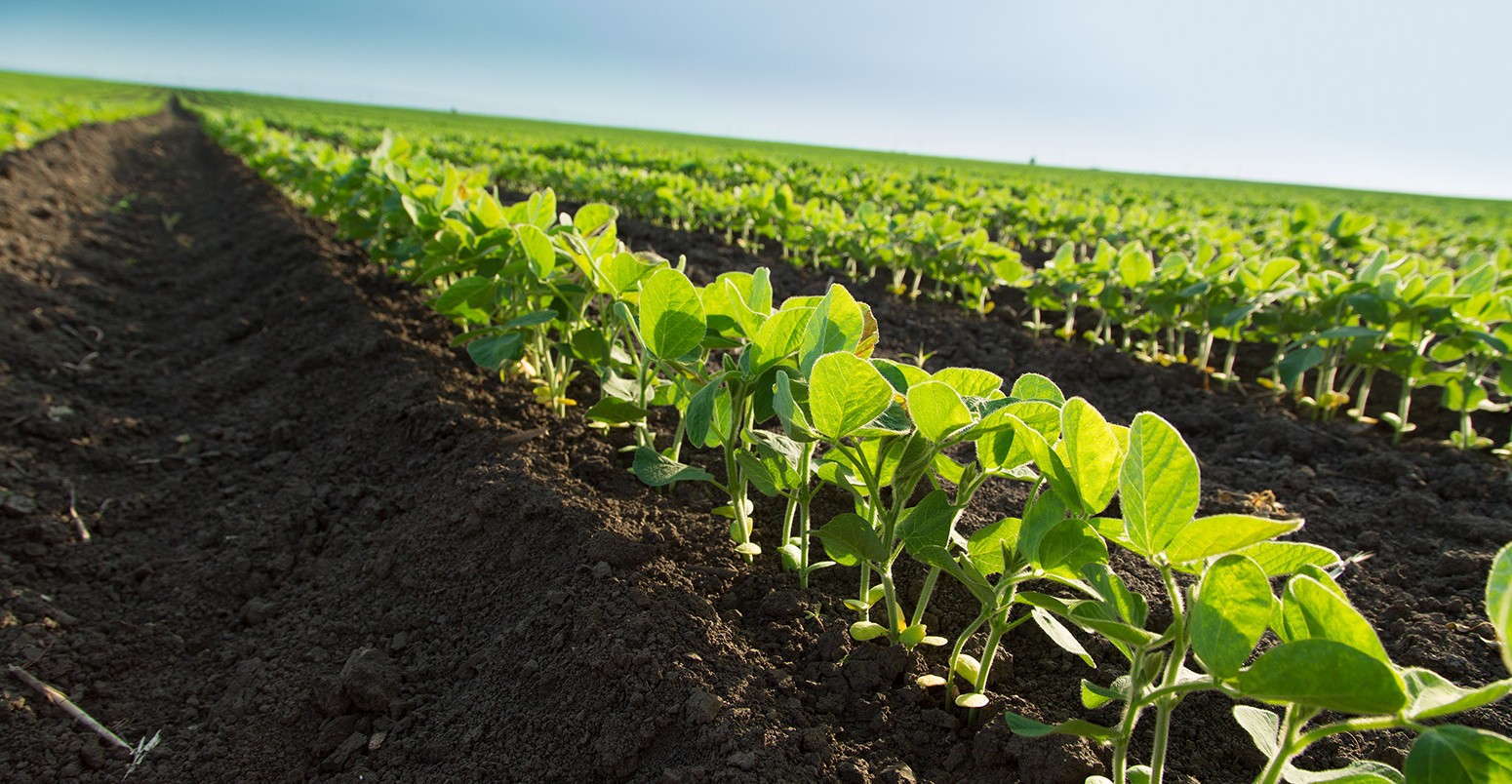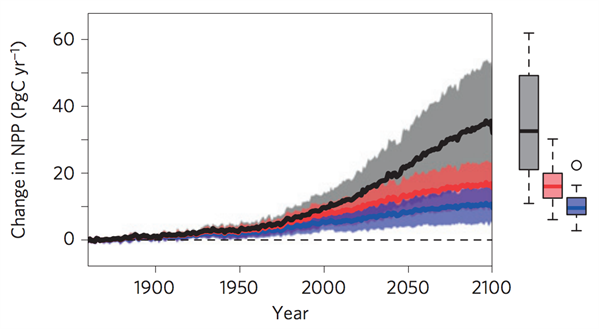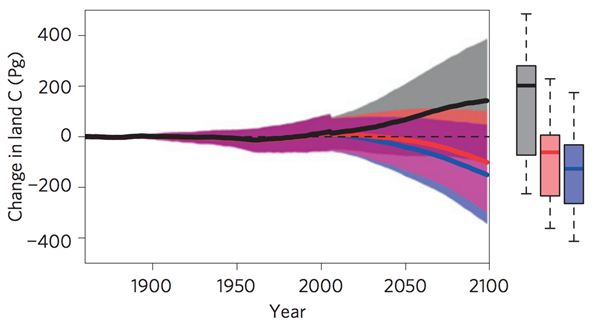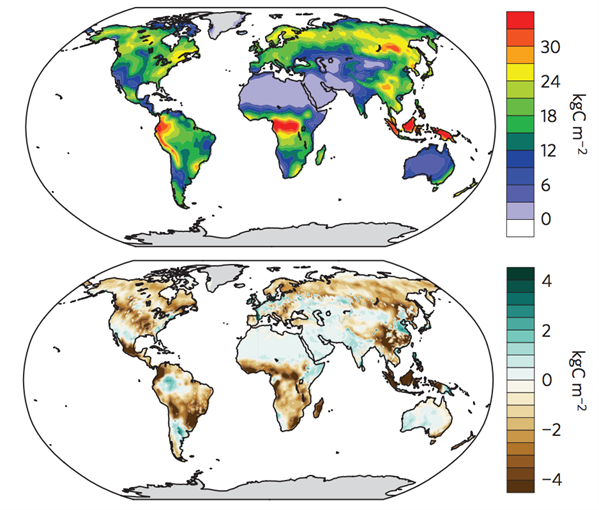
World’s plants and soils to switch from carbon sink to source by 2100, study shows
Robert McSweeney
04.24.15Robert McSweeney
24.04.2015 | 3:40pmEvery year, trees and plants across the world absorb a vast amount of carbon dioxide from the atmosphere.
But a new study suggests this massive carbon sink could instead become a source of carbon dioxide by the end of the century.
This means we might not be able to rely on plants soaking up our emissions for much longer, the lead author tells Carbon Brief.
Extra carbon dioxide
Through photosynthesis, plants convert carbon dioxide, water and sunlight into the fuel they need to grow, locking up carbon in their branches, stems and leaves in the process.
Research suggests that as human-caused carbon dioxide emissions accumulate in the atmosphere, plants will grow more quickly because the rate of photosynthesis speeds up. This is called ‘carbon dioxide fertilisation’.
This argument is sometimes used in parts of the media to suggest that additional carbon dioxide is beneficial for the Earth as extra food for plants.
But research published this week in Nature Geoscience suggests that plants won’t have enough nutrients to make full use of the extra carbon dioxide in the atmosphere. So any benefits will be limited, say the authors.
Nutrient needs
Plants need the right mix of nutrients to grow. Two of the most important nutrients are nitrogen and phosphorus. But there isn’t an endless supply in soils for plants to use, lead author Dr Will Wieder, from the National Centre for Atmospheric Research in Colorado, tells Carbon Brief:
While nitrogen is abundant in the air we breathe, most plants can only take it up from the soil. Nitrogen gets into the soil by being ‘fixed’ from the air by microbes and certain plants, such as soy, Wieder says. Phosphorus primarily originates from rocks, and reaches the soil when they are worn down by the weather.
Nutrients can come from a little further afield as well, Weider adds:
Limits to growth
Most climate models used for the latest Intergovernmental Panel on Climate Change (IPCC) report assume that enough additional nitrogen and phosphorus would be available for extra plant growth. But this might not actually be the case, Weider says:
When Wieder and his colleagues included realistic amounts of nitrogen and phosphorus in their models, they found it limited the boost to plant growth from the extra carbon dioxide.
In the graph below, the black line shows the increase in plant growth the IPCC models project under a high-emissions scenario. Without limiting nitrogen and phosphorus, plant growth increases by 63% by 2100.
When the team included future limits to nitrogen (red line), they found extra plant growth dropped to 29%. With limits to both nutrients (blue line), the boost to growth dropped even further to 20%.

Change in net primary productivity (plant growth) projections from CMIP5 (Coupled Model Intercomparison Project Phase 5) models, under a high emissions scenario (RCP8.5). Coloured lines show average model projection for no nutrient constraints (black), limits to nitrogen (red), and limits to nitrogen and phosphorus (blue). Box plots on right-hand side show range in model results. Source: Wieder et al. (2015).
Carbon storage
Limits to the amount of carbon plants can take up is only part of the story. Warmer temperatures mean carbon held in soils and dead plants will decompose more quickly, releasing more carbon back into the atmosphere, the study says.
This could mean that, on balance, more carbon dioxide is released from the soil than is absorbed by the plants, Weider says:
You can see this in the graph below. Without realistic nutrient limits, models project an increase in the amount of carbon stored in land (black line). But with limited nitrogen (red) and nitrogen and phosphorus (blue), the land releases more carbon than it absorbs, turning it from a carbon sink to a carbon source.

Change in land carbon storage projections from CMIP5 (Coupled Model Intercomparison Project Phase 5) models, under a high emissions scenario (RCP8.5). Coloured lines show average model projection for no nutrient constraints (black), limits to nitrogen (red), and limits to nitrogen and phosphorus (blue). Box plots on right-hand side show range in model results. Source: Wieder et al. (2015).
By 2100, the amount of carbon released by the land could be equivalent to 14 years of current human-caused emissions, the study suggests. These emissions would increase atmospheric carbon dioxide by 66 parts per million (ppm).
You can see the projected change in land carbon storage across the world in the maps below. The reds and yellows in the upper map show areas that historically have held the most land carbon. The dark browns in the lower map show areas with the biggest drop in the amount of carbon the land can store.
Regions of the world where large increases in plant growth are expected are likely to be most limited by availability of nutrients, Wieder says. These include tropical forests, savannahs, boreal forests and tundra ecosystems.

Maps of carbon storage on land. Upper map shows historical levels of storage (1860-69). Lower map shows model projections of the change in storage by 2100 as a result of nitrogen and phosphorus limits, under a high emissions scenario (RCP8.5). Source: Wieder et al. (2015).
Bigger problem
The findings suggest we can’t count on plants to offset the impact of our emissions as much as previously thought, Wieder concludes:
The carbon cycle is a critical part of regulating Earth’s climate. With the land’s ability to take up carbon diminishing this century, the study suggests society will need to compensate by finding other ways to cut back on emissions if we’re to keep temperatures in check.
Main image: Sunrise over a meadow.
Wieder, W.R. et al. (2015) Future productivity and carbon storage limited by terrestrial nutrient availability, Nature Geoscience, 10.1038/ngeo2413
-
World's plants and soils to switch from carbon sink to source by 2100, study shows

